Hoi An, a charming ancient town in Vietnam, has carved out a significant reputation on the global stage, not just for its lantern-lit streets and rich history, but also for its extraordinary food scene. The labyrinthine laneways, bustling markets, and riverside eateries teem with delicious offerings. From vibrant street stalls touting their wares to renowned restaurants showcasing local flair, exploring Hoi An’s food is an adventure in itself. It’s impossible to wander far without encountering tempting aromas and sights, making the pursuit of Hoi An Specialties a highlight of any visit.
Exploring the Vibrant World of Hoi An Street Food
The heart of Hoi An’s culinary identity lies in its street food, where many iconic Hoi An Specialties originated. Dishes now served in more formal settings began as quick, satisfying meals for local workers. Think hearty bowls designed to be enjoyed quickly yet provide lasting energy. These dishes are typically healthy and incredibly flavorful.
Standards across street vendors are impressively high. While most specialize in just one or two items, you’ll find variety around every corner. The best strategy? Look for where the locals gather. A stall or eatery packed with Vietnamese diners is a sure sign you’ve found somewhere special serving authentic Hoi An Specialties. Don’t hesitate to pull up one of those famously tiny plastic stools and join the crowd for a truly local dining experience.
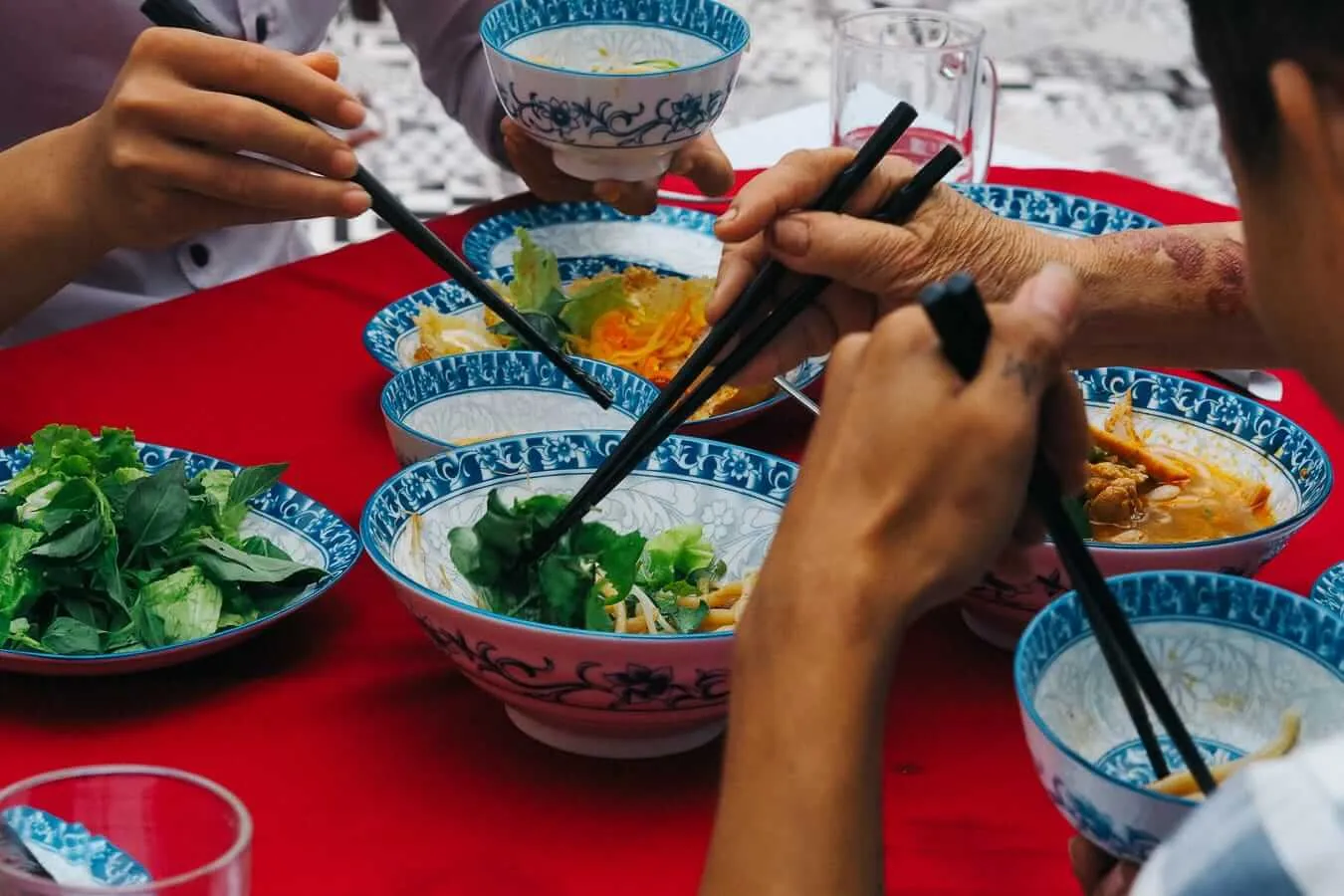 Chopsticks dive into a shared meal of Hoi An speciality dishes. Photo: Agnuush Monstar
Chopsticks dive into a shared meal of Hoi An speciality dishes. Photo: Agnuush Monstar
Iconic Hoi An Specialties You Can’t Miss
Let’s delve into some of the most celebrated Hoi An Specialties. We’ll explore what makes these dishes unique and suggest places where you can sample excellent versions. While pinpointing the absolute “best” is subjective and a subject of passionate debate among locals and visitors alike, these recommendations offer fantastic starting points to experience these must-try local dishes.
Bánh Mì – The Vietnamese Sandwich Sensation
Pronounced “Bahn Mee,” the Banh Mi is a Vietnamese culinary icon, and Hoi An is renowned for crafting some of the finest versions. This delightful sandwich features a crispy baguette filled with a diverse array of ingredients. The two most famous contenders for the title of “best Banh Mi” in town are Banh Mi Phuong and Madam Khanh, affectionately known as the “Banh Mi Queen.”
Discover the Best – Where to Go on Vacation in Florida
Your Ultimate Guide – what to eat in destin florida
Discover Fun Things to Do in LA Today
The debate over which is superior rages online, though the late, great Anthony Bourdain’s endorsement has undeniably boosted Banh Mi Phuong’s popularity. Experiencing both is highly recommended to decide for yourself. Beyond these famous spots, countless other local vendors offer equally delicious takes on this beloved Hoi An Specialty.
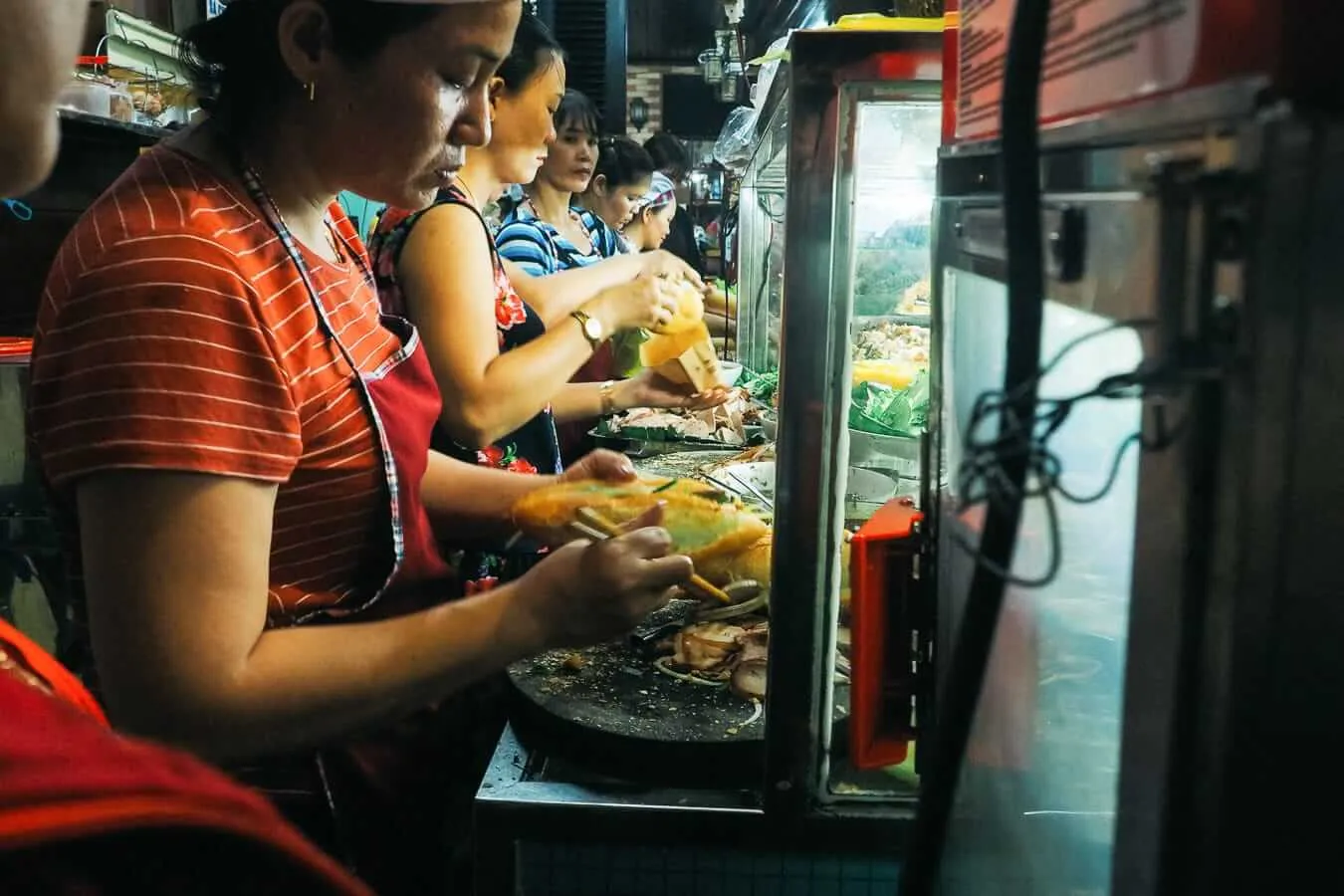 The team at Bahn Mi Phuong create Vietnamese sandwiches for the long line of customers. Photo: Agnuush Monstar
The team at Bahn Mi Phuong create Vietnamese sandwiches for the long line of customers. Photo: Agnuush Monstar
Mì Quảng – Noodles from the Quang Nam Region
Mì Quảng, pronounced “Mee Kwong,” originates from the Quang Nam province, home to Hoi An, hence its name meaning “noodles from Quang.” While served as a soup in other parts of Vietnam, the Hoi An style is distinguished by its minimal, flavorful broth or sauce. The broad rice noodles gain their characteristic yellow hue from turmeric.
This dish combines these unique noodles with a sauce-like broth, fresh herbs, and various protein options. Common additions include prawns, chicken, pork, steamed pork sausage, or quail eggs. The dish is typically topped with sliced banana flower, bean sprouts, herbs like mint, and importantly, crushed peanuts and toasted sesame rice crackers. These toppings add crucial layers of texture, complementing the slippery noodles and rich sauce, making it a complex and satisfying plate among Hoi An Specialties.
Mi Quang is usually seasoned to personal preference with provided condiments like chili and fish sauce. It’s a versatile dish, allowing diners to customize the balance of flavors.
Where to Savor Mì Quảng
Finding a perfect bowl of Mì Quảng is easy in Hoi An, with options ranging from humble street stalls to established restaurants. Mi Quang Ong Hai is frequently praised by food enthusiasts for its consistently high quality. Located slightly outside the core Old Town, it’s worth seeking out for its well-cooked noodles, flavorful broth, and vibrant presentation – a true representation of this regional Hoi An Specialty. Expect to pay around 50,000 VND (approx. 2 USD) for a serving.
Address: 6A, Truong Minh Luong
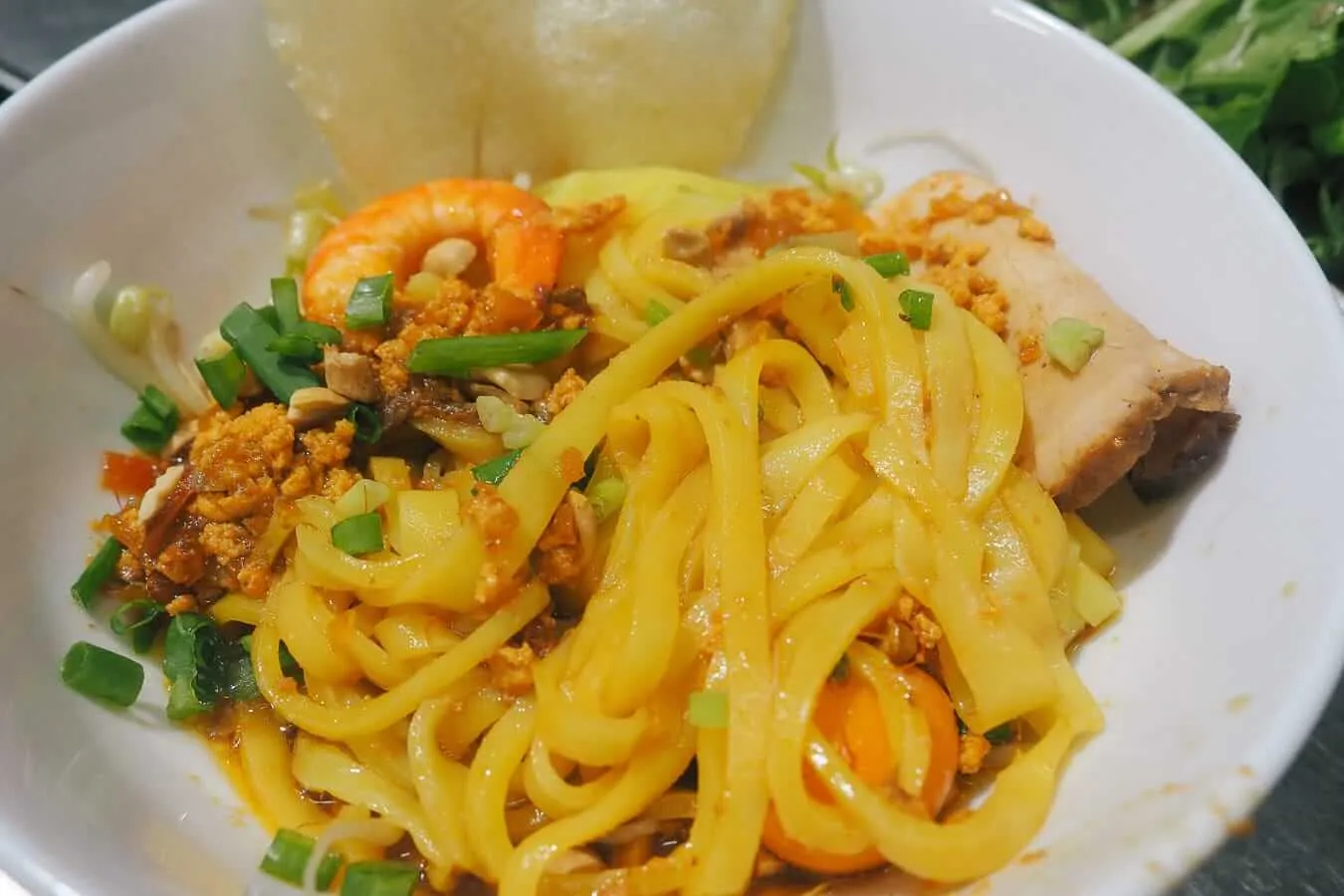 A typical bowl of Hoi An style Mi Quang. Photo: Agnuush Monstar
A typical bowl of Hoi An style Mi Quang. Photo: Agnuush Monstar
Cao Lầu – Exclusively Hoi An Noodles
Cao Lầu, pronounced “Cow Low,” holds a special place among Hoi An Specialties because it is said to be found nowhere else in the world. This distinct noodle dish features pork, local greens, and a rich pork broth served over its signature chewy noodles. The uniqueness lies in the noodles themselves and the water used to prepare them.
Traditionally, the thick rice noodles are hand-cut, shaped, and dried. Crucially, they are soaked in a lye solution made by mixing wood ash from trees on nearby Cu Lao Cham Island with special water drawn from the ancient Ba Le Well (Gieng Bá Le). The mineral and alkaline properties of this specific water are believed to give Cao Lầu noodles their singular texture, slightly sallow color, and unique flavor profile.
The Anatomy of a Cao Lầu Bowl
A typical bowl of Cao Lầu is a thoughtfully constructed culinary experience. It begins with the firm, springy noodles dressed in a minimal yet potent sauce-broth. Layers of texture are added with crunchy fried squares of noodle (sometimes likened to croutons) and tender slices of seasoned pork. The dish is finished with a generous helping of fresh leafy greens and herbs.
Diners can further customize their bowl with fresh chili, fish sauce, or soy sauce provided on the side. This blend of textures—chewy noodles, crispy bits, tender meat, and fresh herbs—combined with the distinctive flavor of the water-treated noodles makes Cao Lầu a truly memorable and essential Hoi An Specialty to try during your visit. Many eateries offer this dish, each with subtle variations, inviting exploration to find your personal favorite.
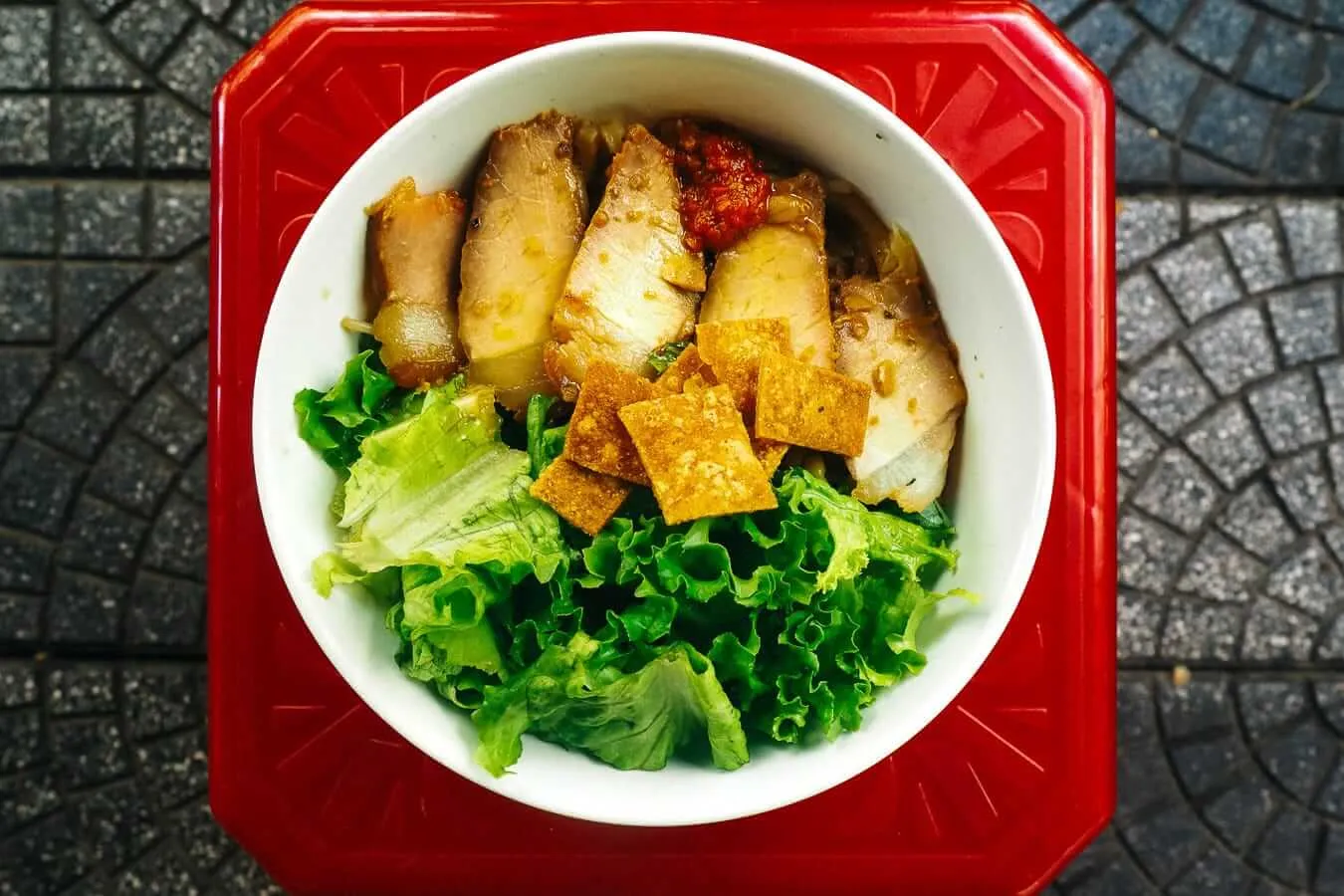 Cau Lau – a dish native to Hoi An. Try it at least once during your visit. Photo: Agnuush Monstar
Cau Lau – a dish native to Hoi An. Try it at least once during your visit. Photo: Agnuush Monstar
Cơm Gà – Hoi An Style Chicken Rice
Cơm Gà, pronounced “Coom ga,” is Vietnam’s take on the ubiquitous chicken rice dishes found across Southeast Asia. However, Hoi An’s version stands out and is recognized as one of the town’s specific Hoi An Specialties. While other countries might feature Hainanese chicken or variations with dark sauces, Hoi An’s Cơm Gà offers a different, uniquely local twist.
This version features finely shredded chicken, often mixed with onions and herbs, served over fragrant rice cooked in chicken broth. A key difference lies in the inclusion of chicken gizzards and livers, which add a distinct savory depth. The dish is typically accompanied by a light, crunchy fried rice and a side bowl of clear chicken and herb broth.
The combination of the subtly metallic tang from the offal, brightened by fresh herbs and onions, mixed with the savory fried rice, creates a comforting yet complex flavor profile. This specific preparation of chicken rice is considered an original Hoi An Specialty and is highly regarded within Vietnam. Numerous stalls and restaurants serve Cơm Gà, each with their loyal following.
A Popular Spot for Cơm Gà
Among the many places serving Cơm Gà, Ba Buoi’s Chicken Rice is particularly famous, often drawing crowds. Be prepared for a wait during peak meal times. A standard serving offers a generous taste of this classic Hoi An Specialty for around 40,000 VND (approx. 1.70 USD).
Address: 22, Phan Chu Trinh
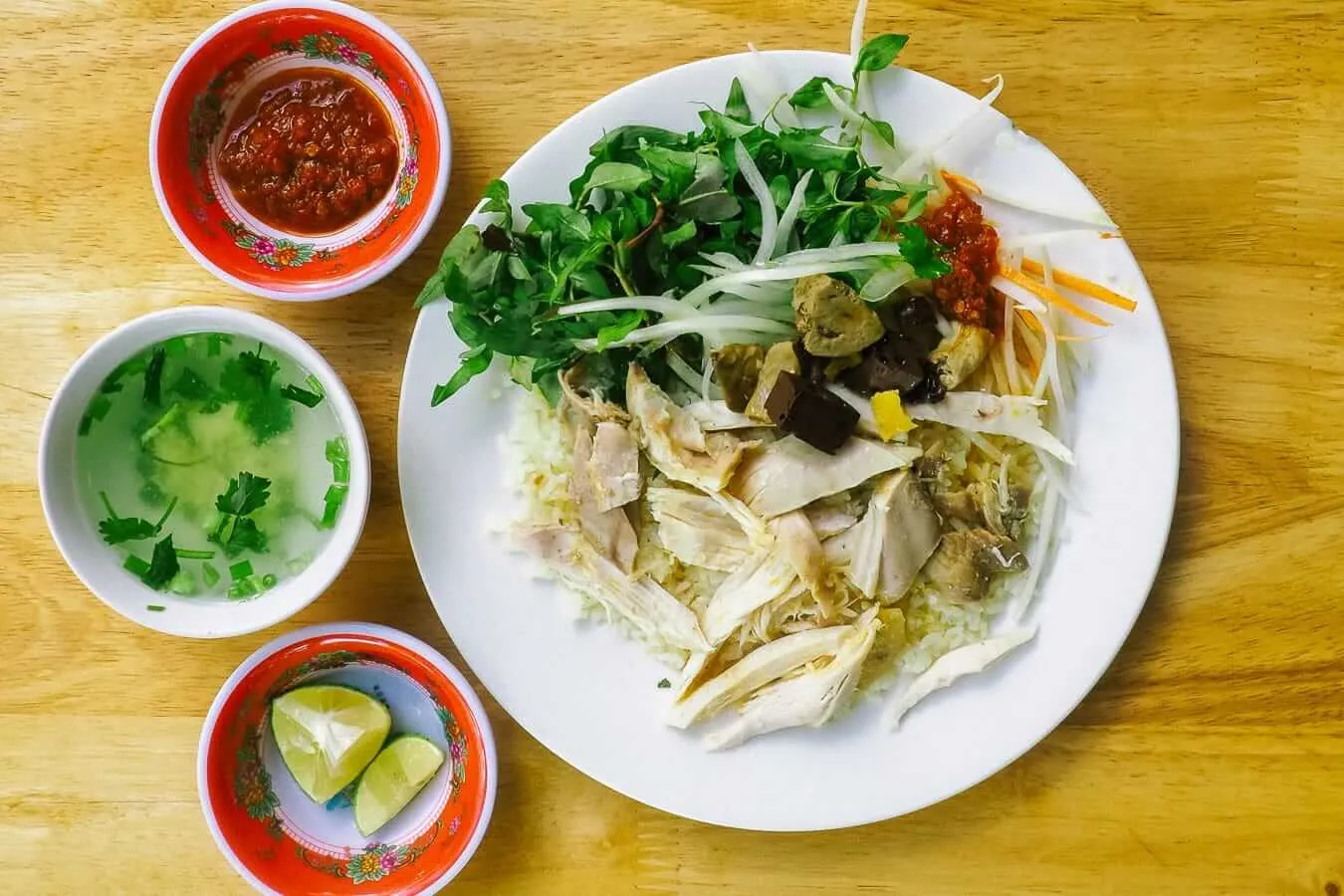 Com ga, Hoi An chicken rice found in all corners of the town. Photo: Agnuush Monstar
Com ga, Hoi An chicken rice found in all corners of the town. Photo: Agnuush Monstar
Bánh Bao Bánh Vạc (White Rose Dumplings)
Known more commonly by its evocative nickname, “White Rose dumpling,” Bánh Bao Bánh Vạc is a delicate and historical Hoi An Specialty. The name comes from the appearance of the steamed dumplings, which are bunched at the center to resemble the petals of a white rose when arranged on a plate.
The recipe for these particular dumplings is said to be a closely guarded secret passed down through generations since colonial times. Like Cao Lầu noodles, the wrappers are made from a specific type of rice ground finely and mixed with alkaline water from the Ba Le Well. This alkaline water contributes to the wrappers’ signature slippery feel and slightly chewy, translucent texture, distinguishing them from typical bready dumpling skins. This technique of using alkaline water is also found in traditional Japanese ramen noodle production, highlighting a fascinating cross-cultural culinary connection.
The filling typically consists of seasoned minced shrimp and spices. After steaming, the dumplings are served adorned with crispy fried garlic, shallots, and green onion, and drizzled with a light, subtly sweet dipping sauce. Interestingly, tradition holds that all White Rose dumplings served commercially in Hoi An are supplied by a single family, descendants of the original inventor. Trying these elegant dumplings at the famous White Rose Restaurant is a quintessential experience among trying Hoi An Specialties. A serving is usually priced around 70,000 VND (approx. 3 USD).
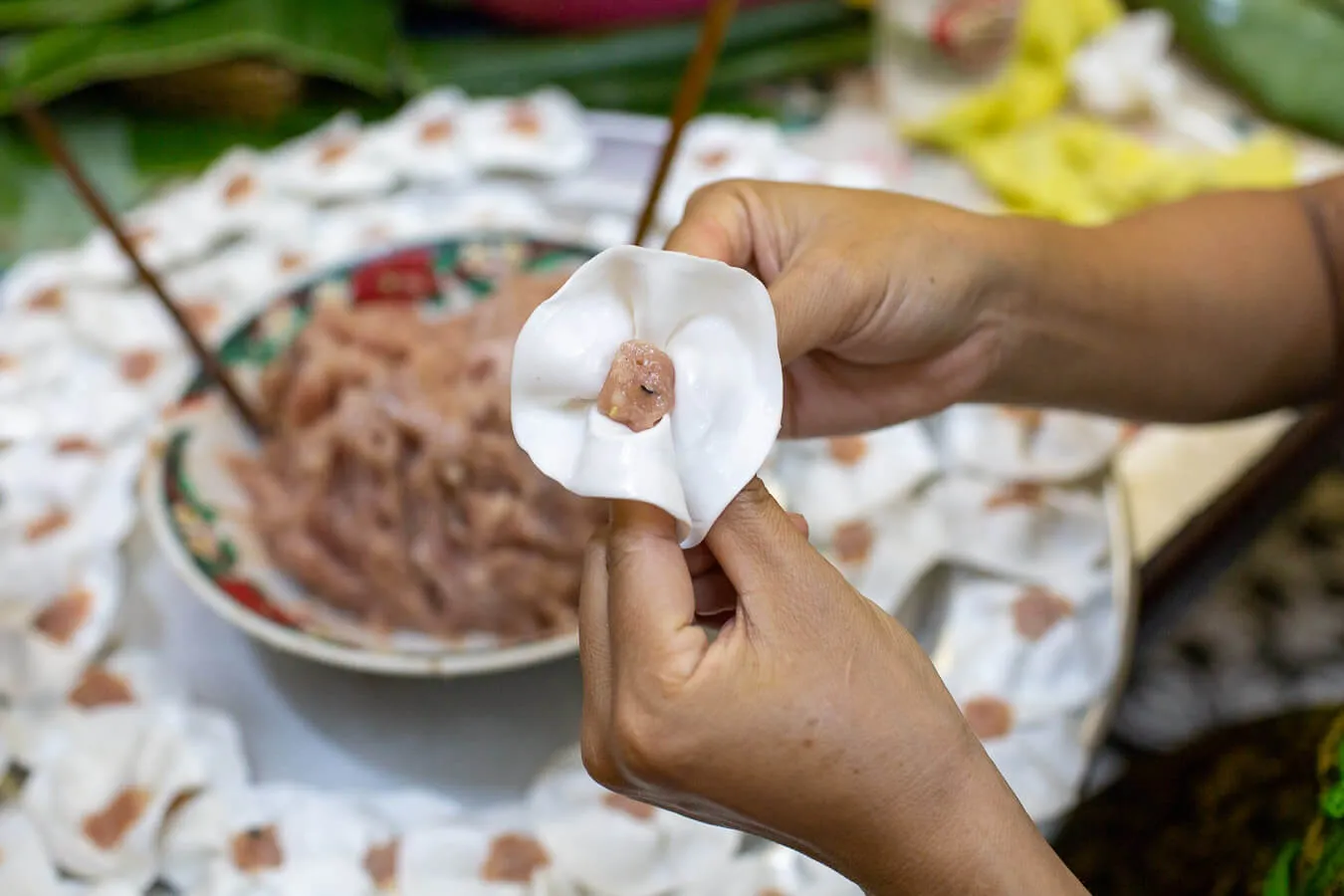 Banh Bao Banh Vac (White rose dumpling) made to a secret recipe at The White Rose Restaurant in Hoi An. Photo: Hidden Hoi An
Banh Bao Banh Vac (White rose dumpling) made to a secret recipe at The White Rose Restaurant in Hoi An. Photo: Hidden Hoi An
Bánh Bột Lọc – Chewy Tapioca Dumplings
Bánh Bột Lọc, pronounced “Barn bot look,” are small, chewy dumplings with a texture often described as tough yet stretchy, almost like a firm gummy bear. These little parcels are made from tapioca flour dough and filled with a mixture of shrimp and pork. Their sticky nature makes them notoriously tricky to pick up with chopsticks!
Despite the playful challenge, Bánh Bột Lọc are beloved Hoi An Specialties. They are typically served with a dipping sauce that is a balance of sweet and spicy, often a fiery chili jam and a tangy Nuoc Cham (fish sauce infused with garlic and chili). The sauces cut through the richness of the filling and complement the unique texture of the wrapper.
You can find delicious Bánh Bột Lọc at various spots throughout Hoi An, including street stalls and food centers. The food court in Hoi An Market is a popular place to sample these chewy delights for around 30,000 VND (approx. 1.30 USD) per serving, offering a great opportunity to try multiple Hoi An Specialties at once.
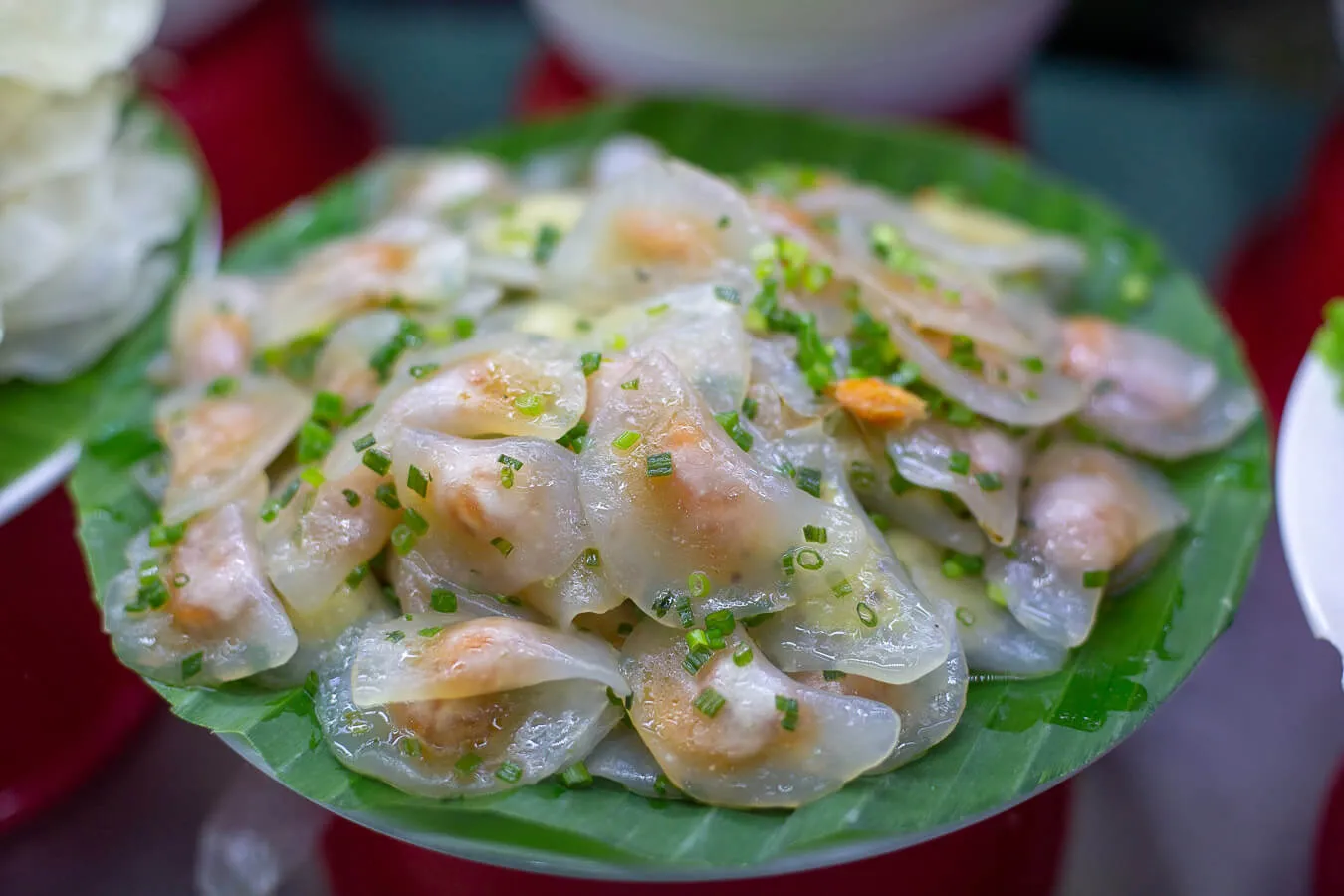 Hoi An specialities – Banh Bot loc – found in restaurants and market stalls all over town. Photo: Hidden Hoi An
Hoi An specialities – Banh Bot loc – found in restaurants and market stalls all over town. Photo: Hidden Hoi An
Hoành Thánh Chiên – Crispy Fried Wontons
Hoành Thánh Chiên, pronounced “Horn Than Shienne,” refers to crispy fried wontons, another delightful Hoi An Specialty. These are made from a mixture of minced pork and ground shrimp, seasoned with onions, and wrapped in thin rice flour skins. The wrappers are folded into shapes resembling ravioli and then deep-fried until golden brown and satisfyingly crispy.
These savory pockets are typically served with a dipping sauce, often a mix of chili, vinegar, and soy sauce, providing a tangy and slightly spicy counterpoint to the rich, crispy wontons. They make for an excellent snack or appetizer, perfect for sharing.
Trying Hoành Thánh Chiên
For a taste of authentic Fried Wontons, look for local eateries specializing in the dish. Anh Dung (Hoanh Thanh Anh Dung) is a small, cozy spot where you can often see the wontons being prepared fresh. This adds to the charm and ensures you’re getting a hot, crispy order. A serving of this popular Hoi An Specialty might cost around 60,000 VND (approx. 2.60 USD).
Address: 14 Ba Trieu
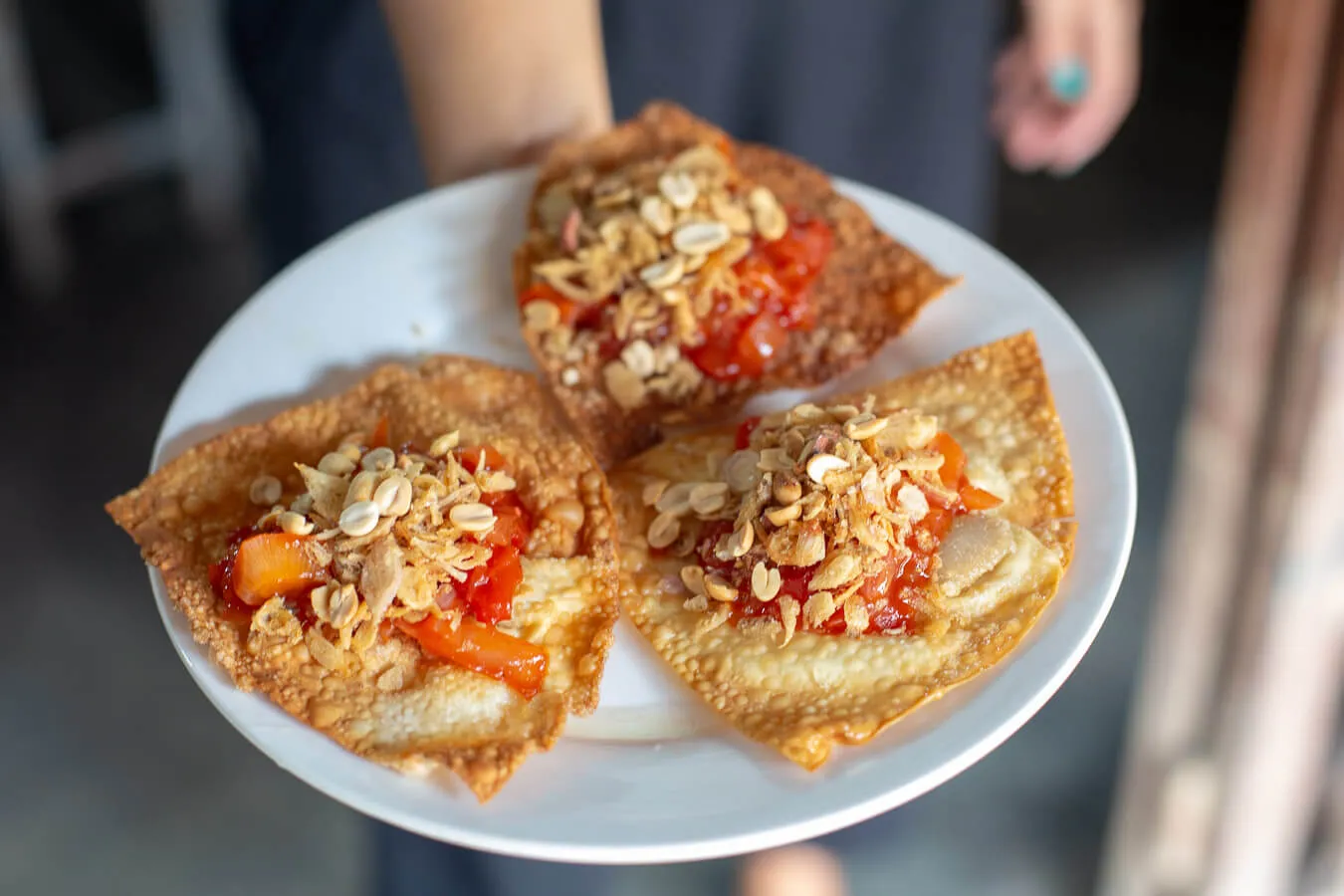 Hoi An specialties – fried wontons with pork and shrimp. Photo: Hidden Hoi An
Hoi An specialties – fried wontons with pork and shrimp. Photo: Hidden Hoi An
Hến Trộn & Bánh Đập – Clam Salad and Smashing Rice Paper
“Hến Trộn,” pronounced “Hen Chun,” and “Bánh Đập,” pronounced “Barn Dap,” are two distinct dishes that are traditionally served and enjoyed together in Hoi An. They offer a beautiful contrast in textures and flavors. Hến Trộn, or minced baby clam salad, is a light and flavorful dish originating from Cam Nam island, just across the bridge from Hoi An’s Old Town.
This salad features small, tender clams tossed with fresh herbs and greens, often brightened by the inclusion of tart star fruit slices. It’s typically topped with crushed peanuts, adding a nutty crunch. The result is a refreshing dish with a subtle, sweet seafood flavor punctuated by bursts of acidity from the fruit and aroma from the herbs.
Bánh Đập, meaning “smashing rice paper,” is the perfect textural counterpart. It consists of two thin, crispy rice paper sheets with a layer of soft, steamed rice noodle sandwiched between them. You eat it by breaking off a piece, folding it, and dipping it into accompanying sauces. These sauces usually include a pungent fermented shrimp paste (mắm tôm – an acquired taste for some), chili sauce, and a sweet fish sauce. The act of “smashing” and dipping the crispy, soft layered rice paper with the flavorful clam salad creates a unique and popular combination among Hoi An Specialties.
Along the waterfront of Cam Nam Island, you’ll find many local restaurants specializing in this pairing. These unassuming eateries offer an authentic setting to enjoy these traditional dishes. Quan Ben Tre is noted for serving good versions of both dishes, with servings costing around 50,000 VND (approx. 2 USD).
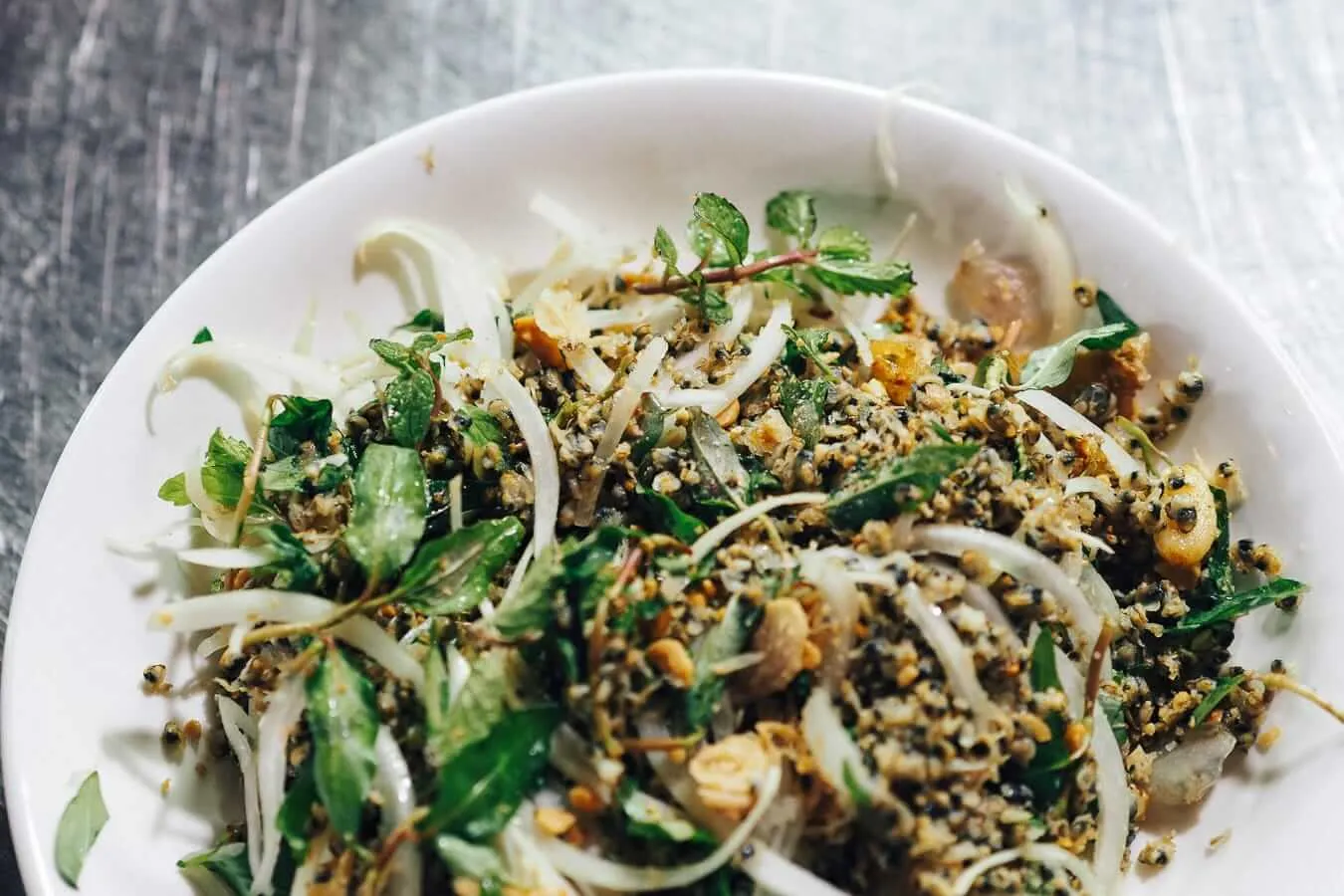 A plate of Hen Tron, minced clams, one of the local specialities found in Hoi An. Photo: Agnuush
A plate of Hen Tron, minced clams, one of the local specialities found in Hoi An. Photo: Agnuush
Seafood – A Coastal Delight
Given its coastal location and proximity to fertile waters, seafood naturally features heavily among Hoi An Specialties. Whether prepared in traditional Vietnamese styles or incorporated into fusion cuisine, fresh seafood is readily available and often reasonably priced. Areas like An Bang Beach are particularly known for their seafood restaurants, offering a wide selection from local catches.
Expect to find dishes featuring clams, various types of fish (often steamed with herbs in banana leaves), scallops, and numerous preparations of tuna. Within the main town of Hoi An, almost every restaurant will feature seafood prominently on their menus, from simple grilled fish to intricate seafood-based dumplings.
For the ultimate seafood experience, consider a trip to the local market, especially early in the morning. The market stalls by the river offer incredibly fresh catches, often still alive. Purchasing fresh seafood along with herbs, noodles, and vegetables allows for a delightful home-cooking experience, providing a deeper connection to the ingredients that form the foundation of many Hoi An Specialties. Be sure to visit before 7 a.m. for the freshest selection, as refrigeration is limited and quality can decline quickly in the heat.
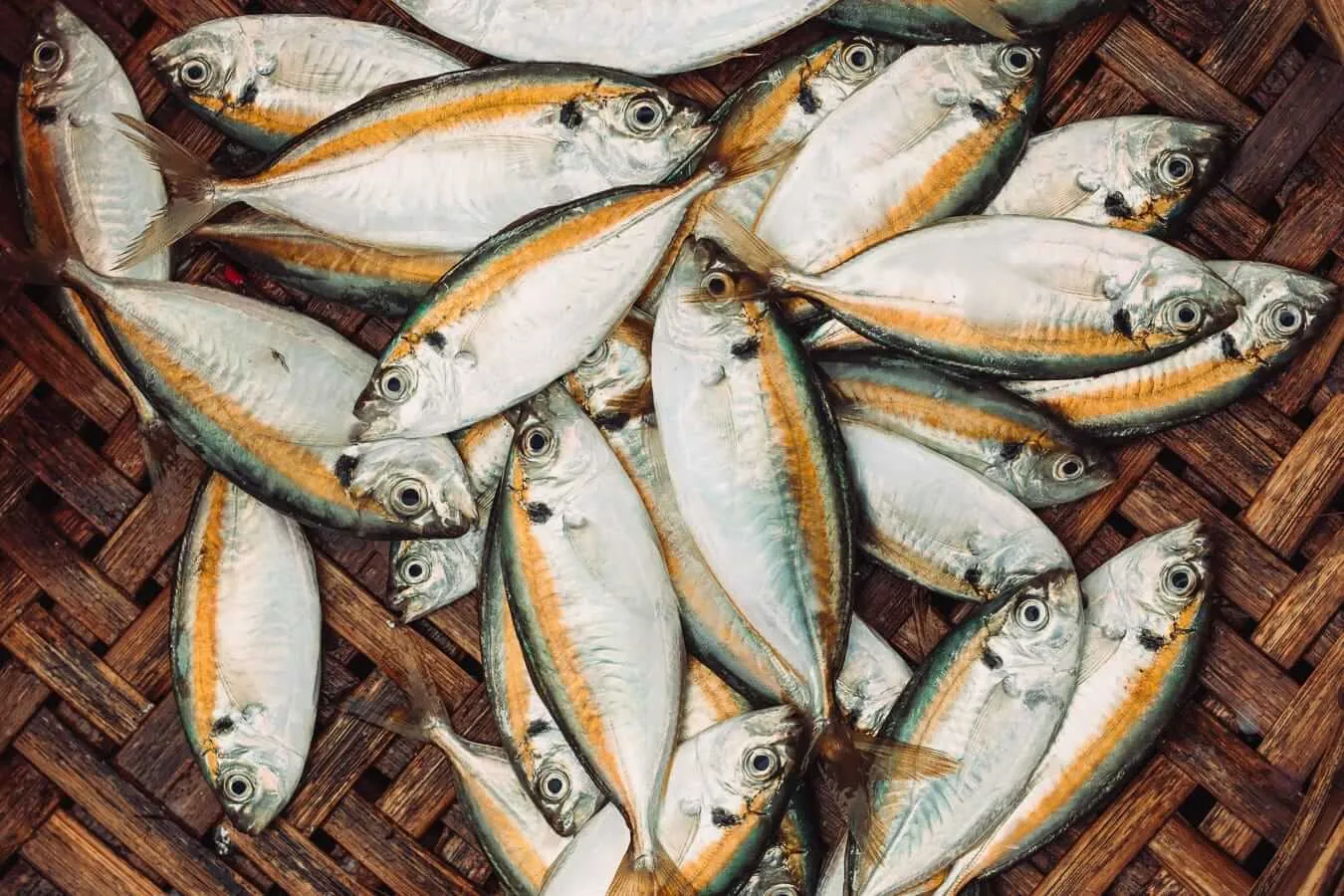 Fresh fish for sale in the Hoi An Market. Photo: Antonia Lira
Fresh fish for sale in the Hoi An Market. Photo: Antonia Lira
While cooking yourself is a great option, numerous restaurants specialize in seafood. A Roi Seafood Restaurant is a popular choice, offering a nice variety of local seafood Hoi An Specialties like clams, fish, prawns, and scallops. Located on Cua Dai street, dishes are generally well-prepared and priced reasonably, typically between 60,000 to 100,000 VND (approx. 2.60 to 4.30 USD).
Chè – The Refreshing Sweet Soup
Chè, pronounced “tcheh,” is a Vietnamese sweet dessert that might be better described as a sweet soup or even a chilled dessert drink rather than a savory soup. Often found at mobile street carts and small hawker stalls, especially along streets like Hoang Dieu, Bach Dang, Phan Cu Trinh, and Nguyen Chi Thanh, Chè is a delightful way to cool down and satisfy a sweet craving with authentic Hoi An Specialties.
Historically, Chè served as a quick energy boost for laborers working under the hot sun. Today, it has evolved into a popular chilled dessert, perfect for combating the tropical heat while exploring Hoi An. It’s a versatile treat, typically served in a glass or bowl, easily enjoyed on the go.
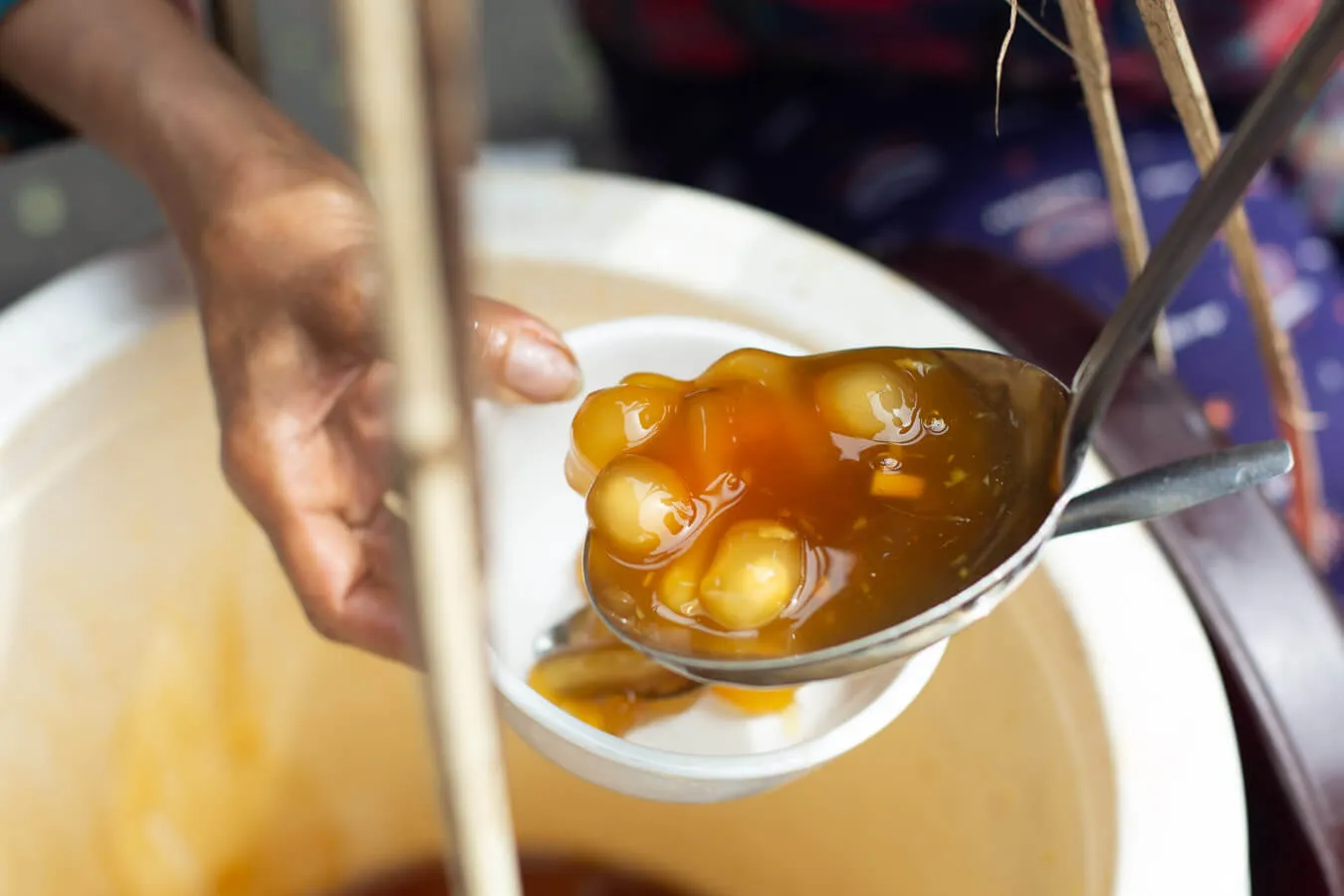 A street vendor in Hoi An serves Che sweet soup. Photo: Hidden Hoi An
A street vendor in Hoi An serves Che sweet soup. Photo: Hidden Hoi An
A World of Chè Variations
The world of Chè is incredibly diverse, with numerous variations using different beans, grains, fruits, and jellies. The base is often sweetened coconut water or bean milk, sometimes flavored with banana oil. Many versions feature tapioca pearls, colorful agar-agar jellies, sticky rice, and other garnishes. A generous scoop of shaved ice is usually added to make it a truly refreshing dessert.
Common types include Chè Bap (made with sweet corn), Chè trôi nước (sticky rice cake with green pea paste), Chè khoai môn (taro), Chè đậu xanh (green bean), Chè đào (red bean), Chè bột lọc (cassava), Chè hạt sen (lotus seed), Chè dảo ngữ (broad beans), and Chè thái bà liên (a colorful mix of fruit jellies). Each offers a unique combination of textures and sweetness, showcasing the creativity within Hoi An Specialties. Beyond street carts, you can find a wide selection at the Hoi An Night Market and places like Che Thung.
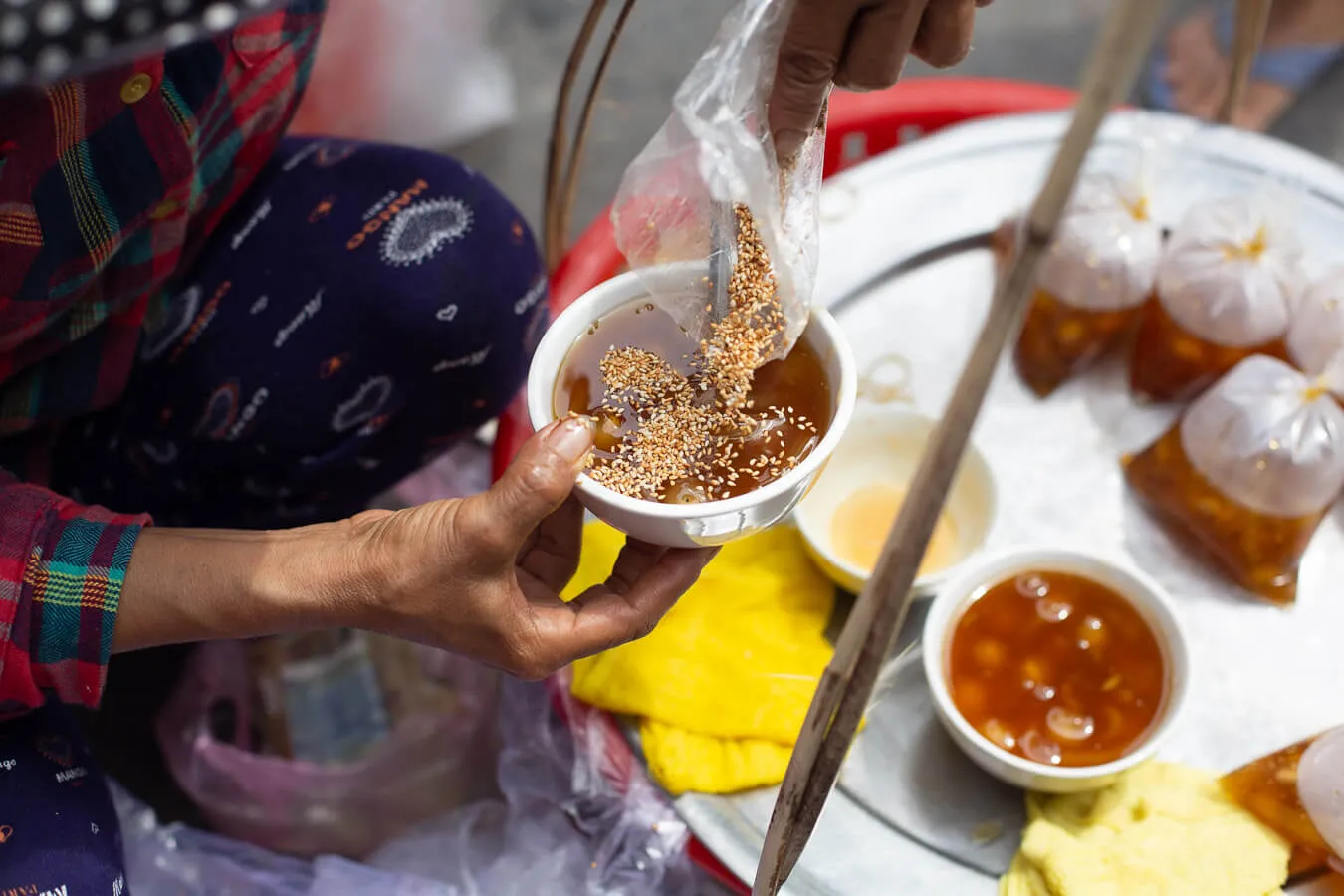 Sesame seeds top a bowl of sweet che served by a street vendor. Photo: Hidden Hoi An
Sesame seeds top a bowl of sweet che served by a street vendor. Photo: Hidden Hoi An
Mango Cake – A Deceptive Delight
Despite its name, “Mango Cake” is neither a cake nor contains mango! This popular sweet snack among Hoi An Specialties gets its name purely from its shape, which vaguely resembles a mango. This small, chewy dumpling is a delightful surprise.
When you bite into a Mango Cake, you’ll discover a filling of crushed peanuts and granulated sugar, encased in a soft, stretchy wrapper made from glutinous rice flour. The white dusting on the outside, which might look like powdered sugar, is simply rice flour used to prevent sticking.
Even with its misleading name, Mango Cake is a delicious and fun treat. It offers a delightful chewiness combined with the sweet, nutty crunch of the filling. You can easily find vendors selling Mango Cake throughout the Old Town and at the An Hoi night market. Prices are very affordable, typically ranging from 3,000 to 10,000 VND (approx. 0.13 to 0.40 USD), making it an easy and tasty Hoi An Specialty to sample while exploring.
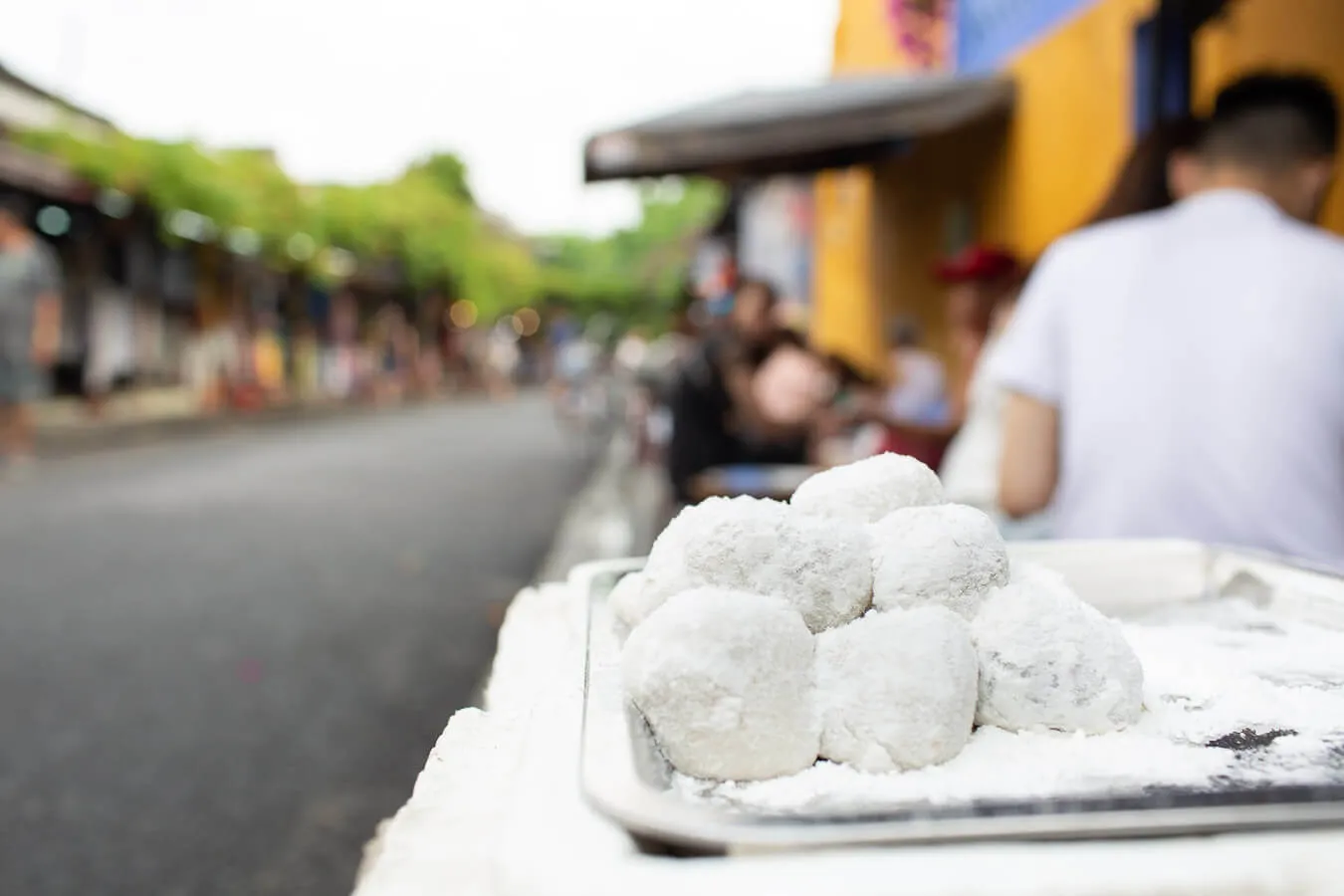 Mango cake in Hoi An. Mango cakes do not contain any mango and are not actually a cake! They are delicious, though. Photo: Hidden Hoi An
Mango cake in Hoi An. Mango cakes do not contain any mango and are not actually a cake! They are delicious, though. Photo: Hidden Hoi An
Frequently Asked Questions About Hoi An Specialties
What are the most famous Hoi An Specialties?
The most famous Hoi An Specialties include Cao Lầu noodles, Mì Quảng, Banh Mi, White Rose dumplings (Bánh Bao Bánh Vạc), and Cơm Gà (Chicken Rice).
Why is Cao Lầu only found in Hoi An?
Cao Lầu’s unique texture and flavor are attributed to the specific mineral content of the water from the ancient Ba Le Well and the use of wood ash from Cu Lao Cham Island in preparing the noodles. This traditional method is exclusive to Hoi An.
What is the difference between Mì Quảng and other Vietnamese noodle soups?
Unlike many Vietnamese noodle soups served in ample broth, Mì Quảng in the Hoi An style features a minimal, flavorful sauce-like broth. It’s also distinguished by its wide turmeric-dyed noodles and toppings like crushed peanuts and rice crackers.
What is Banh Mi in Hoi An?
Banh Mi is a Vietnamese baguette sandwich. In Hoi An, it’s particularly renowned for its fresh ingredients and the quality of the baguette. Famous vendors like Banh Mi Phuong and Madam Khanh are popular places to try this classic among Hoi An Specialties.
What are White Rose dumplings made of?
White Rose dumplings (Bánh Bao Bánh Vạc) are made from a translucent, chewy tapioca/rice flour wrapper mixed with water from the Ba Le Well. They are typically filled with seasoned minced shrimp and pork, steamed, and served with fried garlic and a dipping sauce.
Final Thoughts on Hoi An’s Culinary Scene
For any food lover, Hoi An is an absolute paradise. The town truly bursts with incredible flavors and unique culinary experiences waiting to be discovered. The array of Hoi An Specialties has rightfully earned international acclaim, each dish telling a story of local ingredients, history, and tradition.
Don’t be shy to step out of your comfort zone and sample these famed local foods from diverse settings – be it a bustling street vendor, a lively market stall, or a charming local restaurant. Eating like a local is one of the best ways to connect with Hoi An’s vibrant culture. Feast on these unforgettable Hoi An Specialties until your heart (and stomach) is content!
